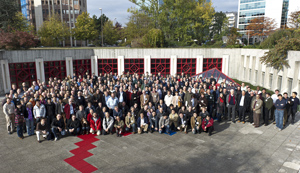 |
 |
|||||||||||||
|
|||||||||||||
|
|||||||||||||
|
As the first in a planned series of workshops, the International Workshop on Linear Colliders had many accomplished missions on the agenda. The ILC, for example, has passed its self-imposed fifty percent mark: half of the nine-cell superconducting radiofrequency cavities produced in the world now reach the desired gradient. The Compact Linear Collider Study (CLIC) has shown that it can generate a high-intensity drive beam by beam manipulation. And both linear collider communities have demonstrated that they get mutual benefit from working together on common issues and meeting once a year to discuss them in plenary.
On the way to the CLIC Conceptual Design and the ILC Technical Design many decisions will have to be adopted, and many outstanding R&D issues solved. Right now, the two communities are working towards forming a complementary pair that waits for new physics results from the Large Hadron Collider LHC and thus the decision which linear collider will get the go-ahead. Another area of close collaboration between the ILC and CLIC communities is the development of detector technologies. Thanks to progress in industry, some technologies have already made such advancements that they are at a maturity level experts only expected them to reach in a few years' time, participants learned in the closing plenary on detectors. “This meeting was a big success,” said Barry Barish in his closing plenary. “We are ready to let the science decide between two linear collider concepts.” -- Barbara Warmbein
Meeting website
Agenda and slides CERN Webcast from the meeting: IWLC Opening: - Introduction seminar: "Towards a Future Linear Collider" and "The Linear Collider Studies at CERN" Steinar Stapnes (CERN) (Part 1) - Plenary session: The LC Roadmap, Rolf Heuer (CERN); Physics prospects, Raman Sundrum (JHU); R&D on Detectors, Jean-Claude Brient (LLR Palaiseau) (Part 2) IWLC Closing: - Plenary session: CLIC-ILC Collaboration, Philippe Lebrun (CERN); Conclusions from GDE, Barry Barish (Caltech); Conclusions from CLIC, Peach Ken (JAI); and Conclusions from Detector, Joachim Mnich (DESY) (Part 1) - Plenary session: Next steps (goals, engineering aspects), Sakue Yamada (KEK); Conclusions from Physics, James Wells (CERN); Closing remarks, Sergio Bertolucci (CERN) (Part 2) |
|||||||||||||
| © International Linear Collider |
